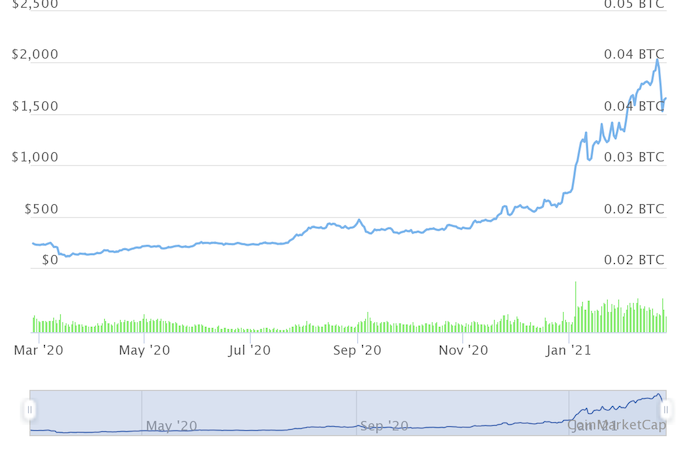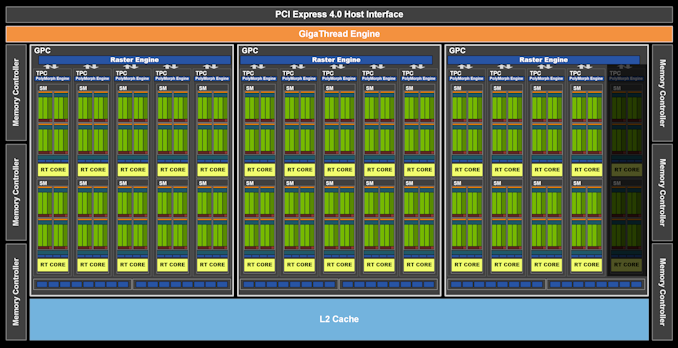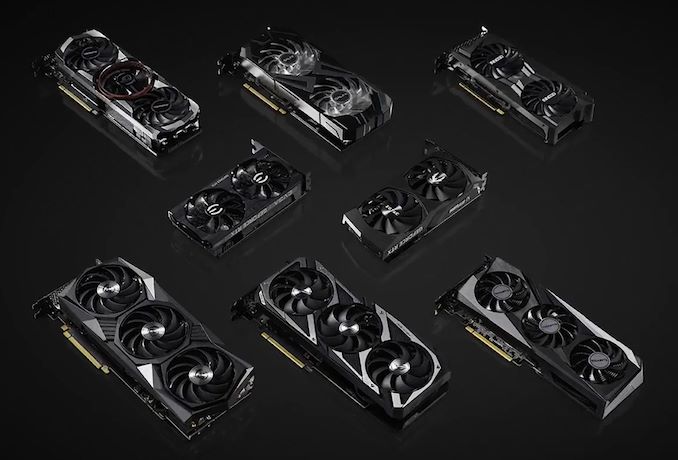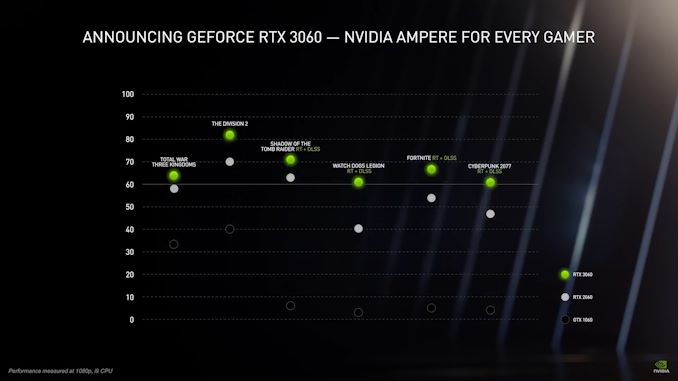Launching Today: NVIDIA’s GeForce RTX 3060 - Aiming For Mainstream At $329
by Ryan Smith on February 25, 2021 9:00 AM EST
NVIDIA this morning is launching their previously announced GeForce RTX 3060. First unveiled back at CES 2021, the latest member of the GeForce RTX 30 series is continuing NVIDIA’s ongoing top-to-bottom launch of Ampere-based video cards, with today’s card in some respects being the most popular one. Aimed at the mainstream market, the RTX 3060 is designed to be a more balanced option for the larger market of gamers who probably aren’t trying to drive high-end 4K displays, but still want the latest graphical features on a 1080p or 1440p display. RTX 3060 cards will go on sale a bit later this morning – at 9am Pacific – with prices starting at $329.
Underpinning the new cards is the first new GPU out of NVIDIA since last fall, GA106. This part has already been shipping in laptops for just under a month as part of the GeForce RTX 3060 Laptop GPU, and now it’s finally coming to desktops. We’ll dive into GA106 more in a bit, but at a high-level it’s a fairly traditional scaled-down NVIDIA GPU design, cutting down on the number of SMs and memory channels to produce a cheaper GPU. Like it’s other consumer siblings, this is being produced on Samsung’s 8nm process – a potential blessing at a time when TSMC is slammed with orders, but not completely meeting NVIDIA’s needs amidst the insatiable demand for chips across the industry.
As previously mentioned, NVIDIA’s 60-tier parts are traditionally their big volume parts for North America and Europe, and the RTX 3060 will be no exception. Though the $329 price tag is arguably on the north side of “mainstream” – and there’s the whole matter of unmet demand – there’s little question that as the cheapest Ampere card yet, it’s going to be the most popular one with gamers. NVIDIA sold nothing short of a massive amount of cards to this mainstream market 3-4 years ago with their Pascal-based GTX 1060 series, and now they’d like to sell that market on an upgrade.
That said, the RTX 3060 comes at a very odd time for the video card industry, enough so that, volume aside, this may be the most important RTX 30 series video card launch yet. Specifically, this is the first GeForce video card to launch since the video card market went cuckoo bananas (to use the technical term) thanks to a spike in the price of the Ethereum cryptocurrency. The compounding demand has made it nearly impossible to get a video card of any sort over the last few months, and has led to NVIDIA taking the unprecedented step of adding an Ethereum throttling mechanism to the RTX 3060 cards. Only time will tell how effective this measure actually is, but addressing the miner problem is the first step towards ensuring a more regular and predictable supply of video cards for NVIDIA’s core gaming market.
But even with those mechanisms in place, pent-up demand for video cards in general means that the supply of cards for today’s launch will go quickly. For those who are fortunate enough to get a card, they will have a significant number of models to pick from, as the absence of a retail NVIDIA reference card means that AIBs’ custom designs making up the entirety of the RTX 3060 lineup. None of the usual suspects are releasing anything too exotic here – at least not right away – so expect to see a mix of dual and triple fan cards at a variety of price points.
| NVIDIA GeForce Specification Comparison | ||||||
| RTX 3060 | RTX 3060 Ti | RTX 2060 | GTX 1060 | |||
| CUDA Cores | 3584 | 4864 | 1920 | 1280 | ||
| ROPs | 48 | 80 | 48 | 48 | ||
| Boost Clock | 1.777GHz | 1.665GHz | 1.68GHz | 1.709GHz | ||
| Memory Clock | 15Gbps GDDR6 | 14Gbps GDDR6 | 14Gbps GDDR6 | 8Gbps GDDR5 | ||
| Memory Bus Width | 192-bit | 256-bit | 192-bit | 192-bit | ||
| VRAM | 12GB | 8GB | 6GB | 6GB | ||
| Single Precision Perf. | 12.8 TFLOPS | 16.2 TFLOPS | 6.5 TFLOPS | 4.4 TFLOPS | ||
| Tensor Perf. (FP16) | 51.2 TFLOPS | 64.8 TFLOPS | 51.6 TFLOPS | N/A | ||
| Tensor Perf. (FP16-Sparse) | 102.4 TFLOPS | 129.6 TFLOPS | 51.6 TFLOPS | N/A | ||
| TDP | 170W | 200W | 160W | 120W | ||
| GPU | GA106 | GA104 | TU106 | GP106 | ||
| Transistor Count | 12B | 17.4B | 10.8B | 4.4B | ||
| Architecture | Ampere | Ampere | Turing | Pascal | ||
| Manufacturing Process | Samsung 8nm | Samsung 8nm | TSMC 12nm "FFN" | TSMC 16nm | ||
| Launch Date | 02/25/2021 | 12/02/2020 | 01/15/2019 | 07/19/2016 | ||
| Launch Price | MSRP: $329 | MSRP: $399 | MSRP: $349 | MSRP: $249 Founders $299 |
||
Moving on, let’s dive into the specifications for NVIDIA’s latest Ampere card. As previously mentioned, this is based on NVIDIA’s new GA106 GPU. At 12 billion transistors, the chip is notably lighter than the 17.4B chip that is GA104, and at a high level it’s roughly equivalent to two-thirds of a GA104 both in the number of functional units and in the transistor count. Out of the fab, GA106 comes with 30 SMs, 48 ROPs, and 6 memory controllers. However for yield reasons, NVIDIA is shipping their leading GA106 card with only 28 of those SMs enabled. So as far as GA106 is concerned, there’s a little more gas in the tank than what we’ll see from the RTX 3060.
With its 28 SMs enabled, RTX 3060 offers a total of 3584 FP32 CUDA cores. Meanwhile everything else in GA106’s SMs is in proportion per the Ampere architecture, so this means there is also 112 TMUs, 112 tensor cores, and 28 RT cores. The ROP count, on the other hand, stands out a bit more here since NVIDIA has significantly trimmed down this aspect of the chip; whereas GA104 had 96 ROPs, GA106 gets just 48. This means that, relative to GA104 and the RTX 3070/3060Ti cards, RTX 3060 is going to be a bit more hamstrung in terms of total pixel pushing power and thus higher resolutions, underscoring how this is a card aimed first and foremost at 1080p gaming.
Given that NVIDIA had decoupled the ROPs from the memory controllers in this generation, I had been hoping we’d see 64 ROPs for the RTX 3060. But as it turns out, that won’t be the case. NVIDIA has not increased the number of ROPs for a 60-tier card since the launch of the GTX 1060 in 2016, so it will be interesting to see what this means for the generational performance of the card, especially in 1080p games that still want to rasterize a relatively large number of pixels.
All of these blocks, in turn, will be clocked a little more aggressively for an Ampere part, with NVIDIA setting the baseline specifications for the RTX 3060 at 1.32GHz for the base clockspeed, and 1.777GHz for the rated boost clock. On paper, this means the RTX 3060 will offer around 80% of the RTX 3060 Ti’s shader and texture performance, with the card’s relatively high boost clock helping to make up for the overall lack of SMs. Meanwhile we’re looking at just 64% of RTX 3060 Ti’s ROP throughput.
On the memory side of matters, GA106 introduces a smaller 192-bit memory bus, which is comprised of six 32-bit memory controllers. This is standard fare for 60-tier cards, and does come with some trade-offs, mainly in terms of memory capacity. At three-quarters the size of the bus on the likes of the RTX 3070, NVIDIA normally opts to include three-quarters the memory, which would have been 6GB. However, as a 6GB card is looking kind of long in the tooth when game consoles have 16GB of total memory, likely impacting the card’s long-term performance prospects, NVIDIA has decided to finally bite the bullet and make the jump to 12GB of VRAM on their mid-tier video cards. The net result is that there’s currently an odd progression/regression in the GeForce RTX 30 lineup – going from 12GB down to 8GB and then back up to 10GB on the RTX 3080 – but at the end of the day it ensures the RTX 3060 ships with enough VRAM to be useful for years to come.
NVIDIA’s choice of VRAM, in turn, ends up being quite interesting. The company’s official specifications call for RTX 3060 cards to use (at least) 15Gbps GDDR6 memory; the GDDR6 is to be expected, the speed grade is not. To the best of our knowledge, none of the GDDR6 vendors offer a 15Gbps speed grade – after 14Gbps, the next speed grade is 16Gbps. This means that in order to meet the 15Gbps requirement, AIBs will need to use 16Gbps chips to begin with. So why the odd choice in memory speed? The most rational explanation is so that it leaves a bit of room for vendors to sell factory overclocked cards, as this way they can sell cards with 16Gbps memory clocks as a premium product without actually exceeding the memory’s specifications. In any case, using 15Gbps GDDR6 gives the RTX 3060 a total memory bandwidth of 360GB/second, 24GB/second more than what the RTX 2060 offered.
With lower performance and memory amounts, TDP is also dropping accordingly relative to the higher-end RTX 30 series cards. NVIDIA is rating the RTX 3060 at 170 Watts, which is 30W below the RTX 3060 Ti, and making this the first RTX 30 series card with a sub-200W TDP. However, much like the other RTX 30 series cards, TDPs are rising on a generational basis. Whereas the GTX 1060 was a 120W card and the RTX 2060 a 160W card, RTX 3060’s 170W TDP is a further 10W higher. If nothing else, this is consistent with what NVIIDA has done with this entire generation of cards, but it means that the RTX 3060 series is going to be more powerful in more than just rendering performance.
An Extra Feature: Throttling Ethereum Mining Performance
As briefly mentioned towards the introduction, the RTX 3060 also introduces an interesting new anti-mining feature for the first time in any NVIDIA GeForce card. Specifically, the RTX 3060 is designed to throttle back on Ethereum mining, essentially capping the mining performance for the cryptocurrency at 50% of the card’s actual (native) rate. As announced by NVIDIA last week, this is part of an effort to segment the gaming and mining markets – and to keep gaming cards from being pressed into a life of chasing digital riches.
When NVIDIA originally announced the throttling mechanism, they merely called it a “driver” feature – raising immediate questions about how this might be bypassed. However since then, NVIDIA has clarified that the feature is actually a mix of driver, hardware, and firmware functionality, relying on a “secure handshake” between the three of them. The involvement of the firmware makes things far more interesting (and far harder to break) since NVIDIA requires signed firmware on all GeForce video cards, meaning that an RTX 3060 card’s firmware can’t be modified nearly as easily as drivers.

One Year Ethereum Price History (Image Courtesy CoinMarketCap)
The outstanding question then is whether this is going to be hard enough to break, at least over the useful lifetime of the RTX 3060 series. Considering that nothing is impossible to break – there are always flaws in consumer-grade software/hardware to exploit – NVIDIA is, if nothing else, inviting an interesting challenge towards breaking their anti-Ethereum security in pursuit of profits. And make no mistake, there’s quite a bit of money at stake to incentivize bypassing the throttle.
Only time will tell in the long-run how well NVIDIA’s security can stand up – and if their forced market segmentation strategy will succeed. But in the short-run, as one colleague put it last week, even half of a profit is still a profit. So NVIDIA’s halving of mining performance may still not be enough, at least at Ethereum’s currently irrational price.
As an aside, some questions have been raised about what the throttle will mean for other workloads. The good news there, at least, is that Ethereum mining has a very distinct workload: it’s essentially a proxy for memory bandwidth. So as algorithm that hammers the memory controllers but not the ALUs, it stands out even among compute workloads. Still, I don’t doubt that we’ll see some edge case testing as people look to verify this.
Partner Cards & Product Positioning
As part of being NVIDIA’s cheapest Ampere video card to date, the RTX 3060 is also the first card that isn’t getting a reference (Founders Edition) release from NVIDIA. So even though this is the first card to use the new GA106 GPU, NVIDIA is comfortable letting the AIBs take the wheel with Ampere’s first purely virtual hardware launch. As a result, hitting the streets today will be a collection of custom cards from the usual regional board partners.
NVIDIA and their board partners have already sent out photos and spec sheets for a number of cards, and for anyone familiar with past generations of 60-tier cards, everything here looks quite familiar. The bulk of cards being announced today are going to be of the dual and triple fan variety, with a couple of single fan cards surprisingly thrown in for good measure. For better or worse, this is the tried and true cooler method for mid-range cards, and the board partners are apt to recycle proven designs – especially if they’re pin-compatible. Meanwhile I have not seen any blower-type cards, though given OEMs’ fondness for them, I wouldn’t be too surprised if there’s someone out there doing them for those customers as well.
Since NVIDIA doesn’t have a reference card of their own, for today’s reviews the company has been sending out cards from long-time partner EVGA. The company’s RTX 3060 XC BLACK GAMING card is a very typical example of a baseline RTX 3060 cards, offering a dual fan cooler and no factory overclock of any kind. It’s also one of the only cards that, judging from some early Newegg listings, will be launching at NVIDIA’s $329 MSRP. So expect to see a lot of this card today in reviews, with retail units moving very quickly due to the price.
Otherwise, an all-custom card launch means that we’re expecting a wide range of performance levels, and an even wider range in prices. Early Newegg listings have indicated that cards will be priced anywhere between MSRP ($329) and over $500, depending on the factory overclock and any other premium features an AIB has added to a specific card. This is a wider variance than we normally see, but then these are unusual times, and AIBs can reasonably count on RTX 3060 cards selling even at higher prices, given how hard it is to find a modern video card on retailer shelves right now.
As always, NVIDIA is targeting an N + 2 upgrade cycle with these latest cards, meaning that the company is particularly pitching them as an upgrade for Pascal (GTX 10 series) owners. Along with the significant feature differences afforded by two generations of improvements – things like RT cores and tensor cores, HDMI 2.1 ports and AV1 decoders – there is also a sizable performance advantage for the newer cards. RTX 2060 owners will not be impressed from a single generation’s gains, but it’s the GTX 1060 owners that NVIDIA really wants to reach.
The bigger challenge for NVIDIA is going to be enticing those Pascal owners to upgrade in light of the higher prices that all of the RTX cards over the last two generations have fetched. The baseline GTX 1060 6GB hit the market at $249 a bit over 4 years ago, so even if we ignore the current crypto craziness, $329 for its Ampere-based successor is a stiff price increase. Mind you, all of the RTX 30 series cards have faced a similar challenge, but it’s really once we get to 60-tier cards that NVIDIA’s regular customer base becomes increasingly focused on perf-per-dollar.
Meanwhile, although today is all about the RTX 3060, NVIDIA does have some competition on the horizon. In a suspiciously timely announcement, yesterday AMD teased that they’ll be announcing new Radeon video cards next week – lower tier products that will almost certainly include an RTX 3060 competitor. To date, NVIDIA has had the $300 to $500 market entirely to itself, and while they will for a little longer, that run will be coming to an end soon enough.
Finally, in one more wrinkle that makes today’s RTX 3060 launch a little different from anything prior, NVIDIA and retailers are also changing when cards will go on sale. Traditionally, card sales start either concurrently with the review embargo (normally 9am ET for NVIDIA), or days later for a soft launch. However for the RTX 3060, NVIDIA has opted to keep the same-day release with a twist, setting the retail release for noon ET. This means that potential RTX 3060 buyers will have at least a couple of hours to check our reviews before they need to commit to buying a potentially hard to get card, which isn’t a massive lead, but is certainly more consumer-friendly than having the cards go on sale before anyone has a chance to read a review.
In any case, given what we’ve seen over the last few months, NVIDIA’s board partners shouldn’t have too much trouble clearing their inventories today. The RTX 3060 Ti flew off the shelves at $399, and with video card demand spiking, the even cheaper RTX 3060 will fly off the shelves even faster. In fact, keeping the card on shelves (and at MSRP) is likely to be NVIDIA’s biggest problem for the next quarter, even if NVIDIA’s Ethereum throttling mechanism remains undefeated. We are in unprecedented times for video card demand, and unfortunately that means that our favorite PC hardware continues to be hard to get. Which for NVIDIA and its partners mean they’ll be able to move everything they can make, but it means gamers will want to be on their toes today if they hope to get an RTX 3060.
| Q1 2021 GPU Product Lineups (Theoretical MSRPs) |
|||||
| AMD | Price | NVIDIA | |||
| $1499 | GeForce RTX 3090 | ||||
| Radeon RX 6900 XT | $999 | ||||
| Radeon RX 6800 XT | $649/$699 | GeForce RTX 3080 | |||
| Radeon RX 6800 | $579 | ||||
| $499 | GeForce RTX 3070 | ||||
| Radeon RX 5700 XT | $399 | GeForce RTX 3060 Ti | |||
| $329 | GeForce RTX 3060 | ||||




















115 Comments
View All Comments
valinor89 - Thursday, February 25, 2021 - link
Thank god that miners only mine ETh on GPU these days and there axist no other altcoins being mined. /sEven then I wonder if even at 1/2 speed it makes more sense to buy these than to buy the dedicated mining cards. At least these can be flipped when the current craze ends or these cards start to loose eficacy at mining. It all boils down to making a proffit, and considering people are mining on laptops, this card will still be used to mine.
Also, has anyone calculated what the speed halving on ethereum does to power efficiency? While they mine slower they might do so more efficiently.
valinor89 - Thursday, February 25, 2021 - link
And it doesn't take long to find out you can make close to 7$ a day with this card mining other coins. As long as the crazyness continues this will pay by itself in less than 2 months.TheinsanegamerN - Thursday, February 25, 2021 - link
Hell I have a couple vega 64s sitting around, I might mine with them and keep my kitchen warm at the same time.imaheadcase - Friday, February 26, 2021 - link
"pay for itself" is kind of a silly thing to say for mining. Its not like you can just go to walmart and spend it still, that is why crypto currency will never be something mainstream, simply not going to work when no one adopts it buy illegal online shops contribute like %80 of its growth.meacupla - Thursday, February 25, 2021 - link
aaaaand it's gone.Smell This - Tuesday, March 9, 2021 - link
**Buy in Store** $779.995 in stock at Duluth
ASUS GeForce RTX 3070 ROG Strix Overclocked 8GB GDDR6
https://www.microcenter.com/product/630686/asus-ge...
(Gets out of the way from Atlanta shoppers)
Hifihedgehog - Thursday, February 25, 2021 - link
"At $329"Correction: the RTX 3060 is starting at $389.99. That's the lowest price I saw at Best Buy and Micro Center, with most prices around the $500 mark, with some as high as $629.99 and $534.99, respectively. The latest back-of-the-napkin calculations squarely peg video card price-to-performance (excluding ray-tracing) no better than (and sometimes worse than) 10 series performance per dollar. That's how far we've regressed: we are paying for the same performance as video cards released five years ago. Normally, you would be paying around half as much for the same amount of performance from half a decade ago at this point. This is one market bubble that is going to burst in NVIDIA and AMD's faces and subsequently nosedive as terribly as prices first skyrocketed. Like with any market, this sort of madness is only sustainable for so long before all hades breaks lose...
nandnandnand - Thursday, February 25, 2021 - link
Bound to happen with the mining boom and gaming demand. Putting in more VRAM than the 3080 added fuel to the fire.On the plus side, we can look forward to the price hitting $329 at some indeterminate point in the future.
Spunjji - Thursday, February 25, 2021 - link
Some day soon, it will only be a little bit overpriced! 😬XacTactX - Thursday, February 25, 2021 - link
I was looking at reviews from other sites and the RX 5700 XT is 2% faster than this card. That card was released in July of 2019 for $400 and now nVidia is releasing roughly the same performance for $330. Not much of an improvement after 1.5 years.I miss the old days when we would get a new GPU every 1.5 years with more than 50% higher performance for the same cost